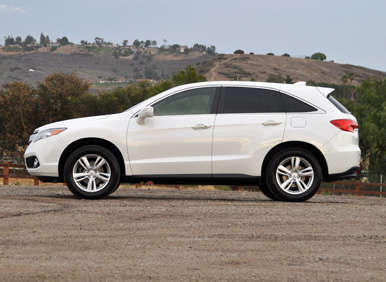Recent Articles
Popular Makes
Body Types
2013 Acura RDX Road Test and Review
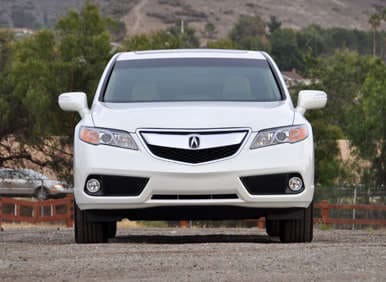
While it is true that the 2013 Acura RDX shares its basic platform and structure with the Honda CR-V, the two crossover SUVs are quite different from one another, even if a cursory examination of the Acura might have a consumer wondering what, exactly, justifies a nearly $7,000 premium over the most luxurious version of the Honda. Having now spent a week driving the RDX, putting more than 1,000 miles on one while taking my family of four for a long weekend trip up the California coast to San Francisco, I can assure you that the Acura’s far more powerful standard V-6 engine, its much better handling, and its more appealing design go a long way toward making the extra expense worthwhile.
The question is, however, not whether one ought to buy the Acura RDX instead of a Honda CR-V. Rather, the RDX’s natural competitive set includes vehicles such as the Audi Q5, BMW X3, Cadillac SRX, Lexus RX, Lincoln MKX, Mercedes-Benz GLK-Class, and Volvo XC60.
With a long history of providing reliable luxury vehicles that are entertaining to drive and deliver impressive value, Acura should have no trouble selling the attractive 2013 Acura RDX, even if it lacks the brand cachet certain competing models provide – at a premium. In my experience, after 1,000 miles in the saddle, I really have only one significant complaint about this sport- and luxury-oriented crossover SUV, and for me, it would be a deal-breaker.
2013 Acura RDX Road Test and Review: Models and Prices
Acura makes it easy to buy a 2013 RDX ($35,215 including the $895 destination charge). All you need to do is decide whether or not you want all-wheel drive ($1,400), and then determine whether or not you want the Technology Package ($3,700).
The Technology Package adds a navigation system, a premium audio system, hard-drive media storage, voice recognition technology including Song by Voice retrieval, real-time traffic and weather reports, a power tailgate, a 4-wheel tire pressure monitoring system, Xenon headlights, and a GPS-linked solar-sensing climate control system. My White Diamond Pearl test vehicle had AWD and the Technology Package, and the window sticker read $40,315.
If you’re looking for ways to personalize the RDX, your Acura dealer offers a range of extra-cost accessories, including a set of 18-inch “diamond-cut” aluminum wheels ($2,248) that closely resemble the rims that Honda bolts to the Accord Sport.
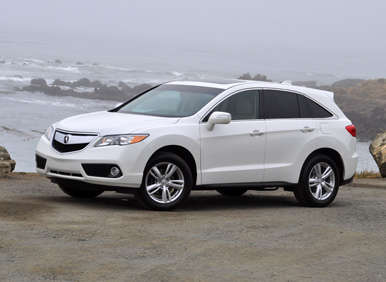
2013 Acura RDX Road Test and Review: Design
- Completely redesigned, inside and out
- Xenon headlights added to Technology Package
Compared to the outgoing RDX, which wore its signature Acura “power plenum” grille and angular “Keen Edge” design theme about as naturally as a 13-year-old with new braces, the redesigned 2013 RDX is gorgeous. From my perspective, the RDX is modeled after the ILX and TSX, and as evidence I present the narrow upswept headlamps, tastefully rendered fender blisters, and rising side character line that actually originates at the bottom of the grille.
In fact, having now just looked at Acura’s entire lineup, the RDX is the best looking of the bunch.
Inside, the Acura RDX is, in my opinion, not quite as unique as the vehicle it replaces. Almost architectural in layout and appearance, the first-generation RDX might have been ugly on the outside, but it was a special place to spend time on the inside, having little in common with other Acuras or Hondas. Comparatively speaking, if someone taped over the Acura emblems inside of the new RDX, a person would be hard-pressed to tell the difference between this and most other vehicles from the Acuronda lineup.
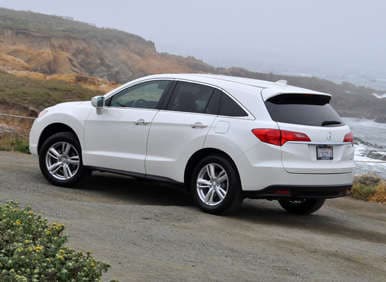
2013 Acura RDX Road Test and Review: Comfort and Cargo
- New front and rear seats
- Less cargo space behind rear seat
- More cargo space with rear seat folded
- Quieter interior with added sound insulation
- Power tailgate added to Technology Package
On the first page of this review, I said I had just one significant complaint about the new 2013 Acura RDX, a deal-breaker from my perspective, and it relates to comfort. This is unfortunate, as one of my favorite things about Acuras, even the little ILX sedan, is that they are comfortable. Not this one.
The driver’s seat offers 8-way power adjustment, is wrapped in soft leather that looks good and feels durable, has a heated bottom cushion, and features wide backrest “wings” for greater comfort and support. So, why wasn’t my six-foot, 250-pound body comfortable? Glad you asked, and there’s nothing like a 1,000-mile road trip to provide a detailed answer.
I wear pants with a 33-inch inseam, and I really could have used another inch or so of seat track travel. Alternatively, Acura could offer a seat that provides a separate bottom cushion adjustment to deliver the right blend of seat height and thigh support. Since neither of these conditions exists in the new RDX, I sit low and splay-legged behind the steering wheel, which makes California’s Interstate 5 an even more unpleasant roadway to travel.
My wife, who is significantly smaller than me, found the RDX’s driver’s seat and driving position very comfortable. However, she complained about the front passenger’s seat, which does not offer height adjustment. As a result, the front passenger sits low in the RDX, and when I rode shotgun while she drove, I found the front passenger’s chair to offer little in the way of thigh support. Also, we both kept tripping over the RDX’s doorsills during our 4-day road trip.
While I’m filling the comfort complaint box with suggestions, I wished the RDX offered heated front seat backs in addition to heated bottom cushions. After a day of visiting San Francisco’s excellent Exploratorium and wandering up and down the Embarcadero from the Ferry Building to Fisherman’s Wharf with a 2-year-old riding on my shoulders, my back needed some serious heat.
Speaking of the offspring, I think our two kids had it best during our California road trip. The RDX’s rear seat is spacious for a small SUV, with plenty of leg and foot room for adults let alone children. And, like the front seating area, there are softly padded places to rest arms and elbows. Still, there is room for improvement. The bottom seat cushion sits high off the ground but is flat, lacking optimum thigh support. The backrest is adjustable for angle, though it still feels a touch too reclined in its most upright position. Additionally, the RDX offers no rear air conditioning controls let alone air vents.
Overall, I remember the Honda CR-V as offering greater levels of comfort than the Acura RDX. The Honda is also a better cargo carrier, equipped with 11.1 cu.-ft. of additional space behind the rear seat compared to the Acura. Nevertheless, my family had no trouble hauling a full load of suitcases, backpacks, a camera bag, a stroller, and more in the RDX. Convenient handles located in the cargo area automatically fold the Acura’s second-row, and the Acura accommodates a maximum of 61.3 cu.-ft. of cargo while the Honda handles 70.9 cu.-ft. of your stuff.
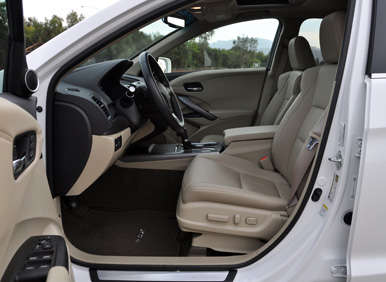
2013 Acura RDX Road Test and Review: Features and Controls
- Standard SMS text messaging
- Standard Pandora Internet radio
- Standard Keyless Access System with push-button ignition
- AcuraLink telematics technology
Despite its generic Acuronda componentry and design, the RDX’s cabin provides logically grouped controls featuring big buttons and knobs that are clearly marked and easy to both find and use. The speedometer and tachometer are models of clarity, and aside from the fact that I prefer to use a tuning knob instead of a tuning rocker switch when changing radio stations, I have no complaints about the RDX’s control layout.
Unfortunately, the RDX’s infotainment system proved mighty frustrating to a husband-and-wife team recalcitrant to pull over to perform navigational tasks, and too impatient to deal with an obtuse voice-recognition system. While the Acura is underway, most features associated with the navigation system can be accessed only via the voice recognition system. However, the RDX’s inability to recognize spoken commands made us absolutely apoplectic at one point, especially after discovering that we turned onto the wrong road after giving up in frustration, which in turn caused us to miss a rare fog-free sunset off the central California coast.
If it’s any consolation to Acura, our iPhone’s Siri assistant was equally clueless, and useless as an alternative.
Take the time to pull over, and the Acura’s navigation system is easy to configure. However, at one point, when searching for the closest Starbucks, the system required an entire input of s-t-a-r-b-u-c-k-s before generating the list because of a single company in the national database that is called Starbuck’s with an apostrophe.
Arrgh.
Furthermore, once programmed, the navigation system frequently issued directives too late, especially on the tight, crowded, multi-lane freeways and one-way city streets of San Francisco. Good thing it quickly re-calculates new routes. It also issued directions that did not match existing highway signage, in particular around the 101/380 interchange west of the San Francisco airport. Additionally, the software had not been revised to navigate to the Exploratorium’s new location on the opposite side of the city from where it used to be situated.
More than once, my wife and I wished we had a $4.95 map from a gas station instead of an expensive Technology Package in the RDX and expensive “smart” phones in our pockets.
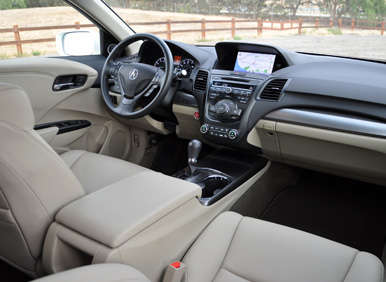
2013 Acura RDX Road Test and Review: Safety and Ratings
- Standard multi-view reversing camera
In addition to the requisite airbag, antilock braking, and stability control systems included on all modern vehicles, the Acura RDX offers little more in terms of safety technology than a standard multi-view reversing camera and a parabolic driver’s side mirror that is curved to help the driver to see in the left blind spot.
If you’re of the mindset that less technology and complexity is better, then this won’t bother you. But luxury suv buyers who want features such as Automatic Collision Notification service, or a blind-spot monitoring system, or rear cross-traffic alert technology, or a lane departure warning system, or a forward collision warning system, or active headlights that help to illuminate the road around dark corners, or a number of other safety features offered on competing vehicles, will need to shop elsewhere. Perhaps even at a non-luxury dealership.
According to the Insurance Institute for Highway Safety (IIHS), the 2013 Acura RDX is a “Top Safety Pick.” The National Highway Traffic Safety Administration (NHTSA) has not performed crash tests on the RDX as this review is written.
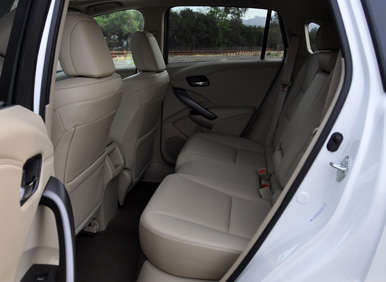
2013 Acura RDX Road Test and Review: Engines and Fuel Economy
- V-6 engine swapped in for outgoing turbocharged 4-cylinder
- Simpler AWD system swapped in for outgoing Super Handling AWD system
- Sequential Shift 6-speed automatic transmission
- Amplitude Reactive Dampers for suspension
- Electric steering
One of the more appealing aspects of the original Acura RDX was its turbocharged 4-cylinder engine and Super Handling All-Wheel-Drive system (SH-AWD), which offered torque vectoring technology and could deliver up to 80% of the engine’s power to the outside rear wheel, which made it particularly engaging to drive.
For 2013, this powertrain combination is scrapped for a conventional 3.5-liter V-6 engine and a new 6-speed Sequential Shift automatic transmission with shifter paddles. Front-wheel drive remains standard, and the optional AWD system is simpler, smaller and lighter, helping to contribute to improved fuel efficiency.
The V-6 makes 273 horsepower at 6,200 rpm and 251 lb.-ft. of torque at 5,000 rpm, plenty for a vehicle weighing a minimum of 3,717 lbs. Variable Cylinder Management (VCM) technology allows the engine to operate on fewer cylinders under low-load conditions, such as when cruising on the highway, in order to conserve fuel.
Fuel economy ratings range between 19 mpg in the city and 28 mpg on the highway, with the AWD models expected to average 22 mpg in combined driving. We extracted 23.9 mpg from the RDX AWD, the majority of those miles covered on the highway with two adults, two children, and a full load of luggage on board.
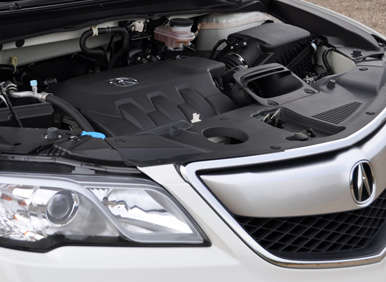
2013 Acura RDX Road Test and Review: Driving Impressions
Dynamically, the new RDX isn’t quite as thrilling to drive as the old RDX, which had a raw, taut, aggressive character. By comparison, the new RDX is more refined, quieter, softer, and more predictable, driving traits that most compact luxury SUV buyers seek. The key phrasing here is “by comparison,” because while the redesigned RDX’s edges have been sanded off, this is still a quick and entertaining crossover SUV with a ride and handling recipe that splits the difference between the stiff Cadillac SRX and the pillowy Lexus RX.
In my opinion, the Acura’s tuning is just right for most people. The V-6 delivers plenty of punch for turning left across traffic or merging onto freeways, the transmission always knows what gear is appropriate, the electric steering is expertly calibrated, the suspension is firm enough to let the driver know what’s happening at the road surface yet soft enough to filter the worst of the information, and the brakes are responsive and faithful. As a daily driver, the Acura RDX is effortless, and that’s exactly how the majority of people want it.
While I believe that enthusiast drivers and people seeking the approval and/or envy of their peers are likely to continue buying the Audi Q5, BMW X3, and Mercedes-Benz GLK, the truth is that the Acura RDX turns in an impressive performance when driven with gusto on a favorite stretch of kinky blacktop. The weak link, based on my driving, is the set of standard P235/60R18 Michelin Primacy MXM4 all-season tires. They howl early, they scrub too much in corners, and they don’t take full advantage of all the suspension and steering have to offer.
Equipped with plenty of power, the V-6 authoritatively motivates the RDX, and the transmission provides a Sport mode in which it matches revs when downshifting and holds gears longer before upshifting. For maximum control, the paddle shifters execute quick and crisp shifts, and the steering wheel to which they are attached is a joy to use while shuffling the SUV through tight S curves, thanks to its perfect rim thickness and soft leather wrapper.
Because the RDX’s suspension is designed to deliver a decent ride quality, this crossover occasionally exhibits too much nosedive, too much squat, and too much roll when pushed hard on an undulating country road. Nevertheless, this is an unexpectedly entertaining vehicle to drive. I just wish it were more comfortable.
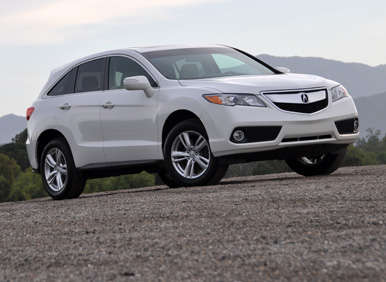
2013 Acura RDX Road Test and Review: Final Thoughts
There’s nothing wrong with the Acura RDX that new tires, reconfigured seating, a re-programmed infotainment system, and additional safety technologies can’t fix. The design, the materials, the quality, the size, and the mechanicals are exactly right. And the price tag is appealing, even if the RDX requires a significant premium over its kissing cousin, the Honda CR-V.

2013 Acura RDX Road Test and Review: Pros and Cons
- Attractive styling
- Quality interior materials
- Excellent control layout and clarity
- Strong and fuel-efficient V-6 engine
- Fun to drive
- Seats lack long-distance comfort
- Dearth of modern safety technologies
- Obtuse voice recognition technology
- Frustrating infotainment restrictions
- Squealing Michelin tires
Acura supplied the vehicle for this review
2013 Acura RDX photos by Christian Wardlaw
